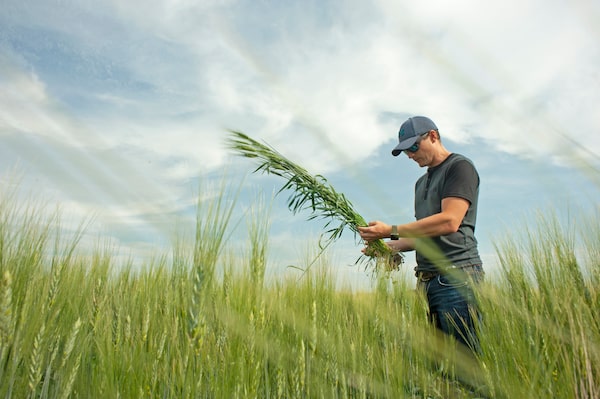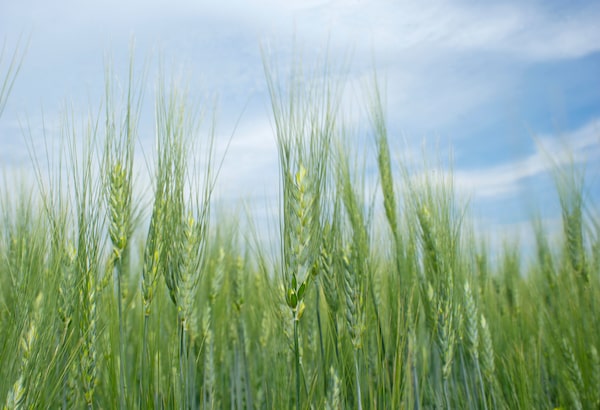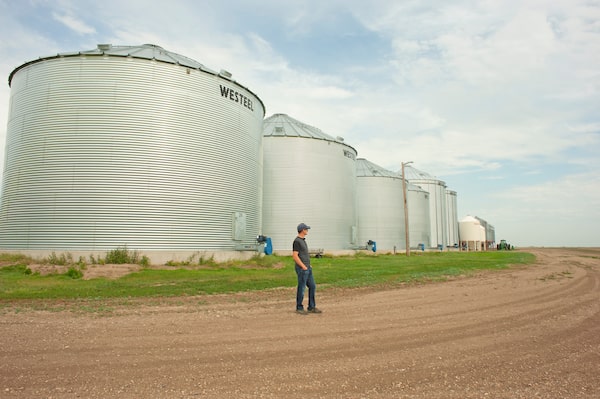
Jake Leguee, a third-generation farmer, increased his durum acreage by 43 per cent from last year, to 5,000 acres from 3,500.MARK TAYLOR/The Globe and Mail
Even before the pandemic hit, Saskatchewan farmer Jake Leguee was planning to plant more durum wheat this year. Global durum production had slowed down in 2019, and prices were on the rise. Then when COVID-19 struck, whole countries went into lockdown, and products made from durum – pasta and couscous, primarily – began to fly off grocery shelves as consumer hoarding took hold.
From his family-run farm 100 kilometres southeast of Regina, Mr. Leguee eyed the surging international demand and a favourable long-range weather forecast, and made his call. Prairie farmers typically make their seeding decisions in November, but they can adjust them up until March, a month before they plant their crops. Mr. Leguee, a third-generation farmer, increased his durum acreage by 43 per cent from last year, to 5,000 acres from 3,500.
“When COVID happened, we thought, ‘What’s this going to do for markets now?‘” he said. “But for Canadian durum, there’s been quite the spike in demand. Really, it’s as simple as people wanting to stock up. And that’s happened all over the world.”
Mr. Leguee wasn’t the only farmer to jump on the opportunity. Overall, Canadian farmers increased their wheat acreage this year by 1.5 per cent, to 25 million acres. But acreage sown in durum wheat increased by 16.2 per cent, to 5.7 million acres, according to Statistics Canada. Of the major durum exporters, Canada is the only country where durum production is rising – it’s up 6 per cent from the five-year average, according to the International Grains Council (IGC).

The durum wheat crop on the Leguee family farm northeast of Weyburn, Sask. Overall, Canadian farmers increased their wheat acreage this year by 1.5 per cent, to 25 million acres.MARK TAYLOR/The Globe and Mail
It’s all to feed the international demand for spaghetti and bread. Durum is a variety of wheat that’s ground into semolina flour and used to make pasta and couscous, or ground into a finer flour for artisan bread and pizza dough. As grocery stores reported shortages this spring, some of the world’s largest durum-producing countries, including Russia and Romania, moved to stockpile their own grain by curbing exports. With just more than a month to go before harvest, Canada is poised to lead the durum market at a time when the world is hungry for it.
There’s a good chance this will pay off for farmers: The price of durum is up 14 per cent in Saskatchewan year-over-year, to $273 a tonne, compared with $239 in 2019. (Meanwhile, the price for Canada’s dominant wheat variety, western red spring, remains flat.) But there are two potential spoilers: sinking demand or a rainy summer that could ruin the finicky grain before it’s harvested.
Prairie farmers had a tough year in 2019. China essentially blocked imports of Canadian canola seed last spring – a move seen as retaliation for Canada’s detention of top Huawei executive Meng Wanzhou on a U.S. arrest warrant. Heavy snow, rain and wind in the fall set back harvests and yielded poorer-quality grain that fetched lower prices. To make matters worse, railway labour strikes and blockades through the winter, in opposition to the Coastal GasLink pipeline in northern B.C., delayed grain and other crops from reaching ports.
Wheat took the biggest hit in the first quarter of this year, with non-durum wheat farm cash receipts (the gross revenue of farm businesses) tumbling 10.7 per cent and durum falling 9.9 per cent over the same quarter last year, according to Statistics Canada.
Durum could be the crop that boosts the bottom line this year. Since it’s used in refined products with stricter standards than other wheat-based products, manufacturers pay a premium for high-quality, amber-coloured durum. Farms in the southern Prairies produce the bulk of Canadian grain, with Saskatchewan allocating the most acres to the coveted wheat variety. But durum is also a risky bet because it’s more delicate. The quality and colour depend heavily on the weather. If too much rain falls on a durum field, the wheat turns white, and the flavour and texture decline more dramatically than for other varieties.

Jake Leguee with a handful of durum wheat on his family's farm.MARK TAYLOR/The Globe and Mail
Manufacturers often sell low-quality durum left over from the autumn harvest at a discount as animal feed. But this year, any leftovers – even the white stuff that suffered from the rain – is being carted away from Canadian farms at higher prices as buyers struggle to meet demand.
“You don’t usually get the kind of prices we were able to see for poor-quality durum,” said Mr. Leguee, adding almost all the durum on his farm fit into that category because of the terrible weather. “Most of the leftover 2019 crop has been exported, even the really poor-quality stuff. But it’s been moving because there’s been demand for it. We were pretty fortunate.”
Richard Gray was also watching the long-range forecast this spring – calling for dry weather for his region of Saskatchewan – and the market swing. A professor of agriculture and resource economics at the University of Saskatchewan, he and his son also own a family farm near Indian Head. When he was deciding what to plant, the price of durum wheat futures was $8 a bushel, noticeably higher than $6 for other varieties of spring wheat. So he planted durum this year for the first time – 300 acres, roughly 10 per cent of his total.

Jake Leguee returns to his truck after scouting a durum wheat field on his family's farm near Weyburn, Sask.MARK TAYLOR/The Globe and Mail
As the pandemic took hold, some of the world’s biggest grain-producing countries, including Russia, Romania and Kazakhstan, placed quotas on exports to keep more of their own wheat from leaving the country. Some countries have since eased or removed restrictions, but another bout of the virus could reignite global concerns.
At the same time, droughts in pandemic-stricken Italy and other major durum-consuming markets in Southern Europe and North Africa (which accounts for 40 per cent of world durum imports) promise to threaten local wheat harvests. Europe could see its lowest durum crop in the past 19 years, dropping to 7.4 million tonnes, according to the IGC. Those regions are home to Canada’s biggest durum customers, with the largest exports in 2019 shipped to Algeria, Italy and Morocco.
“Food security and the fear over supply chains has become more of an issue, and that would include from governments,” Mr. Gray said. “Especially early on when there were threats of disruption, and that may come back this fall if we get a second wave [of the pandemic]. There was a fear that they might not be able to get supplies, so they better order them now.”

Jake Leguee scouts the durum wheat crop on his family's farm northeast of Weyburn, Sask.MARK TAYLOR/The Globe and Mail
Canada typically exports 70 per cent of its wheat and accounts for as much as half of global durum exports. But with Southern Europe and North Africa depending heavily on imports this year, Canadian farmers could see their share of the global market increase to 60 per cent, according to the IGC.
Demand for Canadian wheat isn’t just good for farmers; it has provided a rare bright spot for railways, as well. When the pandemic slowed freight volumes, particularly from the automotive and energy industries, space opened up for grain and other crops. Last year’s grain is still moving across Canada and out to countries around the world at torrid levels. Canadian Pacific Railway moved a record 8.41 million tonnes in its second quarter and shipped 2.76 million tonnes of grain last month, the best June since 2014, when 2.4 million tonnes were transported.
Canadian National Railway also set a new record for total grain volume moved in a crop year. Canada’s largest railway has already moved 30 million metric tonnes of grain, climbing from 26.6 million last year.

Jake Leguee chats with his brother-in-law in the yard of their family's farm.MARK TAYLOR/The Globe and Mail
Todd Hames, chair of the Alberta Wheat Commission and a wheat, canola and pea farmer himself, said that even though shipments were delayed earlier in the year, he delivered all of his wheat contracts for last year’s harvest in June – one month ahead of schedule.
“A lot of that grain would have been moving through July and August because of the rail strike and the blockades,” Mr. Hames said. “The system was backed up. We probably gained that time back and got ahead of it.”
While ports across Canada expect overall traffic to drop amid the pandemic, the Port of Thunder Bay – which ships Western Canadian grain destined for Europe, North Africa and the Middle East – has seen durum exports nearly double, to 935,300 tonnes as of July 26, up from 505,800 tonnes in the same period last year. While exports of other varieties of wheat across all Canadian ports fell by 6 per cent, durum exports climbed by 25 per cent, according to data from the Canadian Grain Commission.
Now, just a month ahead of the September harvest season, everything depends on weather and the continuing effects of the pandemic. As governments reopen their economies, household hoarding and country stockpiling could slow. Meanwhile, global supply of all varieties of wheat are expected to hit a record high. Global wheat production could reach 766 million tonnes this year, surpassing last year’s record of 762 million tonnes, according to the IGC. But though world durum production is expected to climb 2 per cent next year, to 34.2-million tonnes, in large part on an anticipated 20-per-cent jump in Canada, global stocks will fall 6 per cent below the five-year average at a time when consumers are hunting for durum products.
As much as the pandemic spurred panic buying and hoarding, it has also reduced demand for grain in the commercial and biofuel sectors. But while record levels of worldwide supply could dampen prices, durum is an outlier this year.
“Wheat prices over all are somewhat depressed globally because of the fact that we have large supplies of general wheat,” said Bruce Burnett, a director at Winnipeg-based agriculture and commodity analysis firm MarketsFarm, adding that durum is weathering the pandemic better than other varieties. “The average price differential between high-quality durum and spring wheat is in the range of $10 to $25 per tonne. The spread right now is in the $40 to $50 range.”

Jake Leguee stands alongside a row of grain bins. The dry, hot weather is nudging crops along on track for September.MARK TAYLOR/The Globe and Mail
The summer months are a critical time for farmers – excessive rain has resulted in poor-quality durum crops in recent years. Since wheat exports are on a tear this year, global ending stocks – wheat left over for the following crop year – are expected to hit a six-year low, according to the IGC.
“This means that [next year’s] global harvest will need to be bigger to keep total supplies at least stable,” said Amy Reynolds, a senior economist at the IGC. “But much depends on demand. If demand is less than expected in coming months, that could lift the carryover into next season. It is very early to make an assessment, but it is going to take a large world harvest to reverse the growing supply tightness we have seen in recent years.”
From Mr. Leguee’s wheat fields in Saskatchewan, the dry, hot weather is nudging crops along on track for September. But regardless of what international markets want, Canadian farmers aren’t counting their money yet.
“We learned last year that we could have a very good crop right up until the end, and then harvest weather turns against us and it’s taken away,” he said. “So until the crop is off the field and in storage, we do not have control over what we’re going to get.”
Your time is valuable. Have the Top Business Headlines newsletter conveniently delivered to your inbox in the morning or evening. Sign up today.
 Stefanie Marotta
Stefanie Marotta